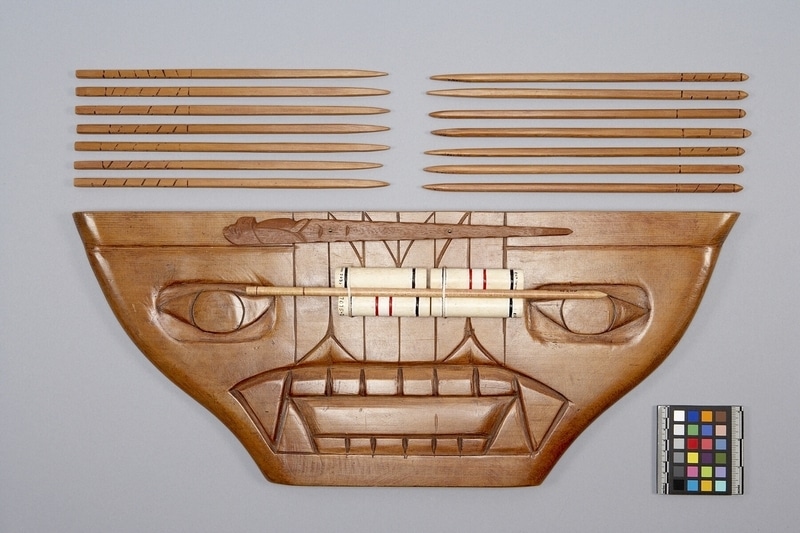Gambling Game Board Item Number: A17073 a-b from the MOA: University of British Columbia

Description
Wooden plaque and counter stick stained reddish brown. The plaque (part a) has a straight edge and curved sides which give it a half-circle shape. On the surface is carved a zoomorphic face (bear) with widely spaced eyes and a wide mouth with teeth. Several vertical lines extend from the top of the piece to the top of the mouth. The carving is two dimensional. The stick (part b) tapers to a point, and has two engraved lines at the wider end. The plaque has two drilled holes with braided twine running through.
History Of Use
These game pieces are part of a game called Slahal or lehal in the Chinook jargon (a trade language). In English the game is known as the bone game. It has spread all over western North America and is still very popular today at events which bring together large numbers of people, such as powwows and canoe races. Holm notes that: "Lehal is played with two pairs of bone cylinders, one of each pair plain, the other decorated with an encircling band of black or a design of lines and nucleated circles. A set of counting sticks, usually ten in number, with a specially marked eleventh now called a "kick stick," completes the equipment. The two teams, of from three to a dozen players each, kneel facing each other in parallel lines, each member holding a short baton with which to keep time on a plank that lies on the ground in front of his team. Two players on one team each handle a pair of bones, and one player on the opposing team tries to guess the positions of the two plain bones. Exuberant gambling songs are sung by the team holding the cylinders, while their opponents try to confuse them with feints. Each correct guess wins a pair of bones, each miss loses a counter. When the guesser has won both pairs, his team takes over and the other side guesses. When all the counters are on one side the game is over (1987:40)."
Cultural Context
gambling; games; social activity
Item History
- Made by Dominic Point (Maker) in Musqueam, British Columbia, Canada during 1972
- Owned by Dominic Point before July 1972
- Received from Leon & Thea Koerner Foundation (Funding source) and Dominic Point (Seller) during July 1972
What
- Name
- Gambling Game Board
- Identification Number
- A17073 a-b
- Type of Item
- game board
- Material
- stain and yellow cedar wood
- Manufacturing Technique
- stained and carved
- Part A
- height 3.8 cm, width 62.2 cm, depth 25.2 cm
- Part B
- height 32.3 cm, diameter 0.8 cm
Who
- Culture
- Coast Salish: Musqueam
- Creator
- Dominic Point (Maker)
- Previous Owner
- Dominic Point
- Received from
- Leon & Thea Koerner Foundation (Funding source) and Dominic Point (Seller)
Where
- Holding Institution
- MOA: University of British Columbia
- Made in
- Musqueam, British Columbia, Canada
When
- Creation Date
- during 1972
- Ownership Date
- before July 1972
- Acquisition Date
- during July 1972
Other
- Condition
- good
- Current Location
- Case 7
- Accession Number
- 0203/0001 a-b